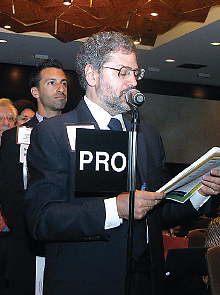AMA Puts Focus on Concussions and Sports
Abstract
Delegates approve a resolution to have AMA advocate that cheerleading be officially designated a sport, thereby requiring school and NCAA oversight and protections.
Head injuries and concussions related to youth sports were on the minds of delegates last month at the annual policymaking meeting of the AMA House of Delegates.
Concussion risk associated with sports was the subject of several resolutions at the meeting, including one sponsored by the AMA Section Council on Psychiatry calling for a report by the AMA’s Council on Science and Public Health (CSPH). That report is expected at the House’s meeting next June.
Delegates also voted to put the AMA on record calling for cheerleading to be considered a sport, with regulations and protections that accompany other youth sports.
In reference committee hearings—where reports and resolutions are debated before being sent to the full House of Delegates—there was nearly unanimous support for a comprehensive report from the CSPH on the epidemiology, risks, and potential consequences of concussion as a result of participation in youth sports. Delegates urged that the report include recommendations for both return-to-play and return-to-classroom authorizations and about who would be best suited to make such authorizations. And speakers emphasized the need to develop a report with input from multiple medical groups and national experts, including evidence-based guidelines recently released by the American Academy of Neurology.

Child psychiatrist David Fassler, M.D., says most parents, teachers, and coaches underestimate the risks and potential consequences of concussions suffered during participation in youth sports.
“I evaluate many young people who have histories of significant head trauma, including sports-related concussions,” said David Fassler, M.D., speaking for the section council and the American Academy of Child and Adolescent Psychiatry. “I’ve seen the effects of these injuries firsthand. While many children and adolescents recover fully from a concussion, a significant number experience serious and lasting consequences including headaches, problems paying attention, impaired memory, irritability, sleep disturbance, and depression. Clearly, such symptoms can and do interfere with their ability to function at school, at home, or with their friends.”
Athletes Describe Concussion Sequelae
Fassler pointed out that a recent conference on concussion in youth sports co-chaired by Eliot Sorel, M.D., a professor of global health at George Washington University School of Public Health, and former Surgeon General David Satcher, M.D., included physicians, researchers, professional athletes, and representatives from a wide range of youth sports associations. The most moving presentations came from young people describing firsthand the lasting cognitive and emotional impact of sports-related concussions on their lives, he said.
“Fortunately, this is an issue that is finally receiving increased attention,” Fassler said, noting that in May President Obama convened a White House summit on this topic. “However, research suggests that most parents, teachers, and coaches still underestimate the risks and potential consequences of concussion as a result of participation in youth sports. Our resolution encourages our AMA to assume a leadership position in addressing the issue of concussion in young athletes. Specifically, it asks the Council on Science and Public Health to prepare a report summarizing the existing data on the risk of concussion in youth sports. . . . Such a report would provide a scientific basis for educating physicians and the general public and for influencing public policy at the state, local, and national levels.”
Cheerleading Should Be Labeled a Sport
The delegates also debated and ultimately passed a Board of Trustees report that asks AMA to advocate that cheerleading be officially designated a sport, thereby requiring schools and the National Collegiate Athletic Association (NCAA) to provide certain safety precautions for an activity that entails flips, mid-air summersaults, human pyramids, and other stunts. Despite objections by a few delegates and legal considerations and increased costs related to Title IX, the 1972 federal law that mandates equal opportunities for men and women in education and athletics, the motion received vigorous support.
“As an emergency physician, I can tell you we see cheerleader after cheerleader in our emergency department during football season,” said Samantha Rossman, M.D., “This is not about Title IX, but about our patients. These girls—and boys—are being flipped 10 and 20 feet in the air and doing incredible athletic feats.”
Melissa Gerretson, M.D., speaking for the Academy of Pediatrics, said, “Cheerleading is a very serious sport that requires serious training and safety equipment.” She added, “If you ask the NCAA to call it a sport, it has to provide the necessary safety precautions.”
Richard Corlin, M.D., a past AMA president, noted that many schools have insurance programs to deal with the health costs of injuries to athletes. “Some of those policies are very specific that they will cover only injuries related to officially designated sports,” he said. “Young people involved in cheerleading need to be afforded the same degree of insurance coverage.” ■
Reports and resolutions approved by the AMA House of Delegates can be accessed here.



